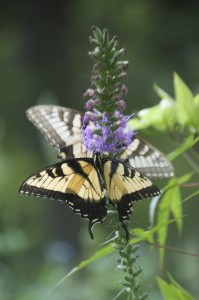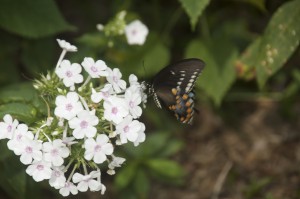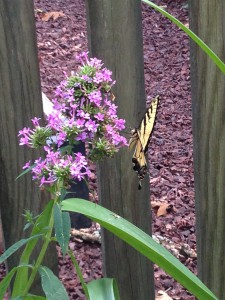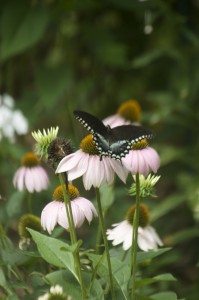Unbelievably, it’s been 4 months since I posted to this blog! My, how time does fly. I’ve been through the spring wildflower season, most of the summer vegetable season, and now the gardens are winding down due to heat and lack of rain. But there are still a number of hardy plants hanging in there for the pollinators to feast upon.
I’ve been moaning and groaning about not having many butterflies this year, when lo and behold they showed up last week! Tiger Swallowtails, both black and yellow, and for the first time ever, Spicebush Swallowtails. The Gulf Fritillaries have laid a bazillion eggs and now the Maypops are covered with caterpillars of all sizes. The Swallowtails have deposited their eggs on the fennel. I brought half of them in and put them in my butterfly hatchery to protect them from the birds. Good thing, too, since all the rest were gone today. And since they weren’t big enough yesterday for me to think that any of them had formed a chrysalis, I’m assuming there are some baby birdies somewhere with a full tummy today. (And did you know that it takes between 5,000 and 6,000 insects for a pair of birds to raise a brood to maturity. My second batch of bluebirds just fledged, along with 10,000-12,000 insects they consumed.)
Once again, my natives seem to be the best lure for the butterflies. They mostly preferred the Liatris, which is also one of my favorites-beautiful fuzzy lavender blooms on a five foot stalk. With so many blooms per stalk, they are bound to be a top choice-lots of food in one place. Kind of like grazing at the buffet. In this picture, a butterfly appears to be reflected in a mirror, but it is actually two butterflies, one with it back to the camera the other with it underside facing the camera.
 Right up there with the Liatris in attracting the butterflies was the Joe Pye Weed. I cringe when I call it ‘weed’, because that name may scare some people off from this beautiful flowering perennial. I have two kinds-one is about 10 feet tall and the other is a dwarf, reaching only about 4 feet tall. Each is topped off by clusters of pink blooms that are butterfly, bee, and moth magnets. In this picture you can see three yellow and one black Tiger Swallowtail enjoying a meal. Bumblebees, sweat bees, honey bees, moths-all kinds of critters rely on this plant.
Right up there with the Liatris in attracting the butterflies was the Joe Pye Weed. I cringe when I call it ‘weed’, because that name may scare some people off from this beautiful flowering perennial. I have two kinds-one is about 10 feet tall and the other is a dwarf, reaching only about 4 feet tall. Each is topped off by clusters of pink blooms that are butterfly, bee, and moth magnets. In this picture you can see three yellow and one black Tiger Swallowtail enjoying a meal. Bumblebees, sweat bees, honey bees, moths-all kinds of critters rely on this plant.
The Phlox cultivar is very attractive to the Tiger and Spicebush Swallowtails. I think this is the ‘Davidii’, but not sure. I didn’t have to wait long to get pictures of the butterflies on the Phlox. I bought a new phlox last week and put it in the ground Saturday, and noticed that the Spicebush butterfly was visiting the few remaining blooms today. I pruned back the old bloom heads, and hope they will put out a new flush of blooms soon.
The pink Phlox, Phlox paniculata ‘Jeana’, is the best performing Phlox in the garden-no signs of powdery mildew, stays upright no matter how tall it gets, and is spreading a a nice rate. The Swallowtails flit between this Phlox and the Liatris across the vegetable garden. They are so accustomed to me being out there, I can get within a few inches and watch them probing with their long proboscis for nectar. I need to get the video camera out there and make a nice video of the butterflies drinking nectar.
I have three kinds of coneflowers in the gardens, Purpurea, which is the species, and two cultivars-Smooth and Tennessee Coneflowers. All are equally attractive when in bloom, but the flowers present quite differently-one kind has flat petals, another petals that curve upward and another with petals that curve backwards. I’m loving some of the new cultivars that I see in bloom in the nurseries right now, but have to have some evidence that they haven’t hybridized the nectar out, making them unattractive to pollinators. When I see pollinators on them in the nursery, I’ll spring for a few of those to add another dimension of color to the beds. Perched her on top of a coneflower is the Spicebush Swallowtail, distinguished from the Black Swallowtail by the absence of orange spots on the upper side of the wings.
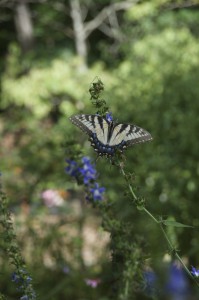 The Tall American Bellflower (Campanulastrum americanum) has surely outdone itself this year. They have been blooming for weeks, with no end in sight. I bought this plant last year at the Native Plant Society sale at Stone Mountain. There was only one, and they didn’t want to bother with making a sign for just one plant so I said “I’ll take it!” And, boy, am I ever glad I did! It’s blue is about the purest blue I have ever seen in the garden and the butterflies, bees, and flying critters love it. Today I saw quite a few bumblebees on it, but some butterflies stopped by for a sip too.
The Tall American Bellflower (Campanulastrum americanum) has surely outdone itself this year. They have been blooming for weeks, with no end in sight. I bought this plant last year at the Native Plant Society sale at Stone Mountain. There was only one, and they didn’t want to bother with making a sign for just one plant so I said “I’ll take it!” And, boy, am I ever glad I did! It’s blue is about the purest blue I have ever seen in the garden and the butterflies, bees, and flying critters love it. Today I saw quite a few bumblebees on it, but some butterflies stopped by for a sip too.
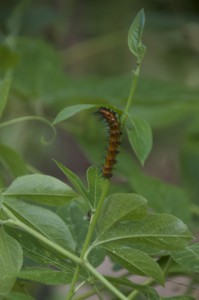
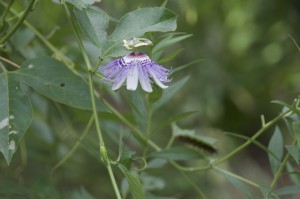 I didn’t see any Gulf Fritillaries today, but they left their calling cards. Dozens of orangish caterpillars in all stages of development on the Maypops are soon going to start forming chrysalises assuring me of the continuation of these beautiful orange butterflies in my garden. The Maypops have been a little lazy blooming this year, probably due to the drought, and I’ve been a lot lazy in removing the strays that come up all over the garden. Glad now I left those strays, because they are hosting many caterpillars. Unfortunately, the birds are also chowing down on these caterpillars, but I think enough will survive to provide butterflies for the garden. I put two pictures here, one to show a large fritillary cat to make them easy for others to recognize, and the other is the bloom of the Maypop with a caterpillar in the background.
I didn’t see any Gulf Fritillaries today, but they left their calling cards. Dozens of orangish caterpillars in all stages of development on the Maypops are soon going to start forming chrysalises assuring me of the continuation of these beautiful orange butterflies in my garden. The Maypops have been a little lazy blooming this year, probably due to the drought, and I’ve been a lot lazy in removing the strays that come up all over the garden. Glad now I left those strays, because they are hosting many caterpillars. Unfortunately, the birds are also chowing down on these caterpillars, but I think enough will survive to provide butterflies for the garden. I put two pictures here, one to show a large fritillary cat to make them easy for others to recognize, and the other is the bloom of the Maypop with a caterpillar in the background.
By next week, the six foot tall Boneset and the 12 foot tall Ironweed should be in full bloom, assuring the pollinators of a new smorgasbord to delight. Everyday in the garden brings new delights, and I am always anxious to get out there and see what new plant is blooming, what new insect is in the garden, and what new veggie is ready to be picked.
Native plants in the landscape really draw in the pollinators. Many of them will take nectar from both native and nonnative plants, but for many of them, there is a single type of plant that can host the caterpillar. If you love Gulf Fritillaries, you’ll have to plant Maypop. For Spicebush Swallowtails, you need a spicebush (duh). The Monarchs will be migrating soon, and I’ve made sure to have plenty of milkweed planted just for them. That’s the only host plant on which they will lay their eggs. The Pipevine Swallowtail hosts on the Pipevine, Aristolochia. I don’t have any cats on the pipevine yet, but there’s always hope. It’s fairly recently planted. Maybe next year!
Natives plants are a consuming passion for me. I have planted hundreds of natives in the yard-serviceberry, grancy graybeard, Yellowwood, viburnum, stewartia, dogwoods, hollies, red and white buckeyes, hawthorns, oakleaf hydrangeas, sourwood, pawpaw, and beautyberry. These trees and shrubs will provide nectar for insects and hummingbirds from spring til mid summer. Then they will provide berries and seeds for the birds and other wildlife during the fall.
I plant all kinds of native flowering plants. Some are just too pretty to live without, even if they are critical for the pollinators. These are usually finished blooming long before the pollinators are active. Some of my favorites, other than those mentioned above are Cardinal flower, Wild Bee Balm, Tickseed Coreopsis, New England Aster, Georgia Asters, Clethra, Flat topped Aster, Native Coral Honeysuckle, Trumpet creeper vine, Thimbleweed, and penstemon. There are tons of others, but a longer list would become tiresome for readers. Please check out the GNPS webpage and facebook page. The web address is www.gnps.org. The West Georgia Chapter also has a facebook page and a web page at wgawildflowers.org. You’ll find interesting articles, upcoming events and plant sales, as well as pictures of wildflowers.
If you can wade through the advertising, you’ll find this page helpful in deciding what to plant for the particular butterflies you want to host. There are links on the page with lists of host plants, butterflies in your geographical area, and many other fun things to know about butterflies.
http://www.butterfly–garden.com/
But don’t forget that there are many more efficient pollinators than butterflies, and they are quite pretty themselves, if you like bugs!

